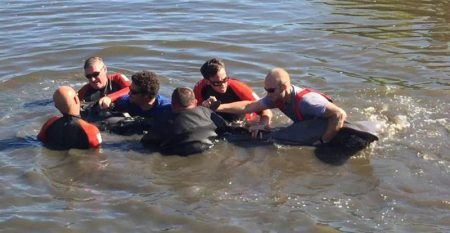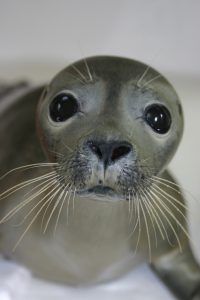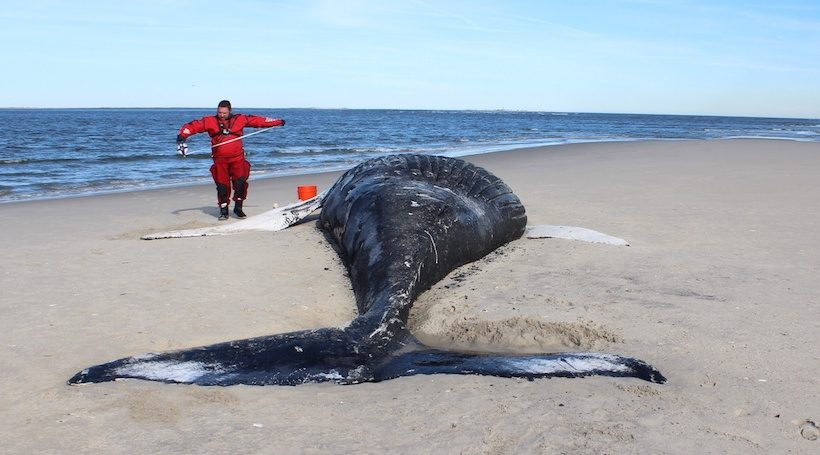When the phone rings, Robert Schoelkopf never knows for sure what to expect. Some calls require him to rescue stranded dolphins or injured sea turtles. Others alert him to a wayward manatee or seal. And there was that one call about a beached 70-foot whale.
“We never know,” says Schoelkopf, the director of Brigantine’s Marine Mammal Stranding Center. The center is the only rescue agency of its kind in the entire state, covering all 1,800 miles of coastline. Relying on more than 300 volunteers, they rush off to beaches around New Jersey to rescue, rehabilitate and then release a wide range of sea creatures. The calls can come on any day, at any time.
“We can’t say if in two weeks we’re going to be busy or not at all. It depends on weather patterns and conditions with the animals. We’ve had years where we had two or three calls a day – usually about dolphins this time of year. The bottlenose dolphins come up and give birth, so they’re traveling around with their babies right off shore.”


Marine Mammal Stranding Center staff and volunteers help a wayward dolphin return to sea.
Schoelkopf, who co-founded the center in 1978 with his wife Sheila Dean, says the organization has been called to assist with rescuing marine life from different states. They’ve also helped other organizations investigate the deaths of animals that have washed ashore in what Schoelkopf calls an “unusual mortality event,” such as the deaths of 42 humpback whales around the East Coast – including two in New Jersey – in the past six months.
“When we are notified an animal is stranded or injured locally, we will call one of our volunteers who is within 15 minutes of the beach and ask them to get photos and email them to us so we can determine our first course of action,” he says.
The volunteers, who Schoelkopf calls the “eyes and ears” of the nonprofit, are then tasked with sitting near the marine animal on the beach until assistance arrives. “We want to keep people from bringing their children or dogs down to the animal to take pictures,” says Schoelkopf.
In the first seven months of this year, the center made nearly 100 rescues. The summer tourist season always increases that number.
“We have to worry about people going a lot faster on boats than they should, not realizing there are things that live in the water beneath them,” Schoelkopf says.
Calls have come in for sea turtles that have suffered blunt-force trauma after being hit by jet skis. Larger animals, like dolphins, are sometimes hit by boats when they’re surfacing to breathe or feed. This summer, the center has been caring for a seal whose flipper was amputated after a boat propeller hit it.
The center has responded to more than 4,800 calls for injured or stranded whales, dolphins, seals, sea turtles and other animals over the last 40 years, though Schoelkopf’s work with marine life started well before then.
“I used to do dolphin shows on the pier in the 1970s, and we started getting calls on the pier from people seeing animals on the beach, such as sea turtles and dolphins,” he says. “They came to us because we were familiar with marine animals, so we responded to see what we could do to help them.”
After serving as a hospital corpsman in the Marines, Schoelkopf says he figured if he could patch up a Marine, he could patch up rescued animals.


Rescued seal pup Tak.
Word spread, and the volume of calls Schoelkopf began receiving prompted him to open the Marine Mammal Stranding Center. There have been a number of memorable rescues since then, like the time the center took in an abandoned seal pup.
“The [mother] seal came up to the shore near the Takanassee Beach Club in Monmouth Beach and, unfortunately, at that time in June some people were already on the beach and saw the activity down by the water and ran to see,” he explains. “They chased the mother back in the surf, and the newborn harbor seal was left with its umbilical cord still attached to it, all alone on the beach.”
The pup was named Tak, after the beach where it was born and rescued. After being cared for at the Marine Mammal Stranding Center, Tak had imprinted on humans and couldn’t be returned to the sea, so he was sent to an Indianapolis zoo, where the seal spent 28 years before recently dying.
“It was an interesting experience with an animal like that, because it bonded so much with humans,” Schoelkopf says, recalling the early days of Tak’s time at the center. “When it was at the zoo, it preferred to go with the trainer to sit with them and lay in their laps rather than play with other seals. After 28 years, that is something special.”
Since its humble beginnings, the Marine Mammal Stranding Center has been relocated from its original digs in the Gardner’s Basin section of Atlantic City to the barrier island of Brigantine. Today, the team includes eight full-time staff members, several part-time employees, including three stranding technicians who are trained in rescuing and rehabilitating marine life, and a number of interns.
In addition to rescuing and rehabilitating marine life, the center also hosts a number of outreach programs and educational activities at its Sea Life Education Center. Open to the public, the center gives visitors the opportunity to learn about the local sea animals that call the Jersey Shore home.
“We have a lot of life-sized fiberglass images of the sharks found in local waters, and this panics some of the people who can’t believe they’re swimming in water where shark lives,” says Schoelkopf. “It’s funny watching their expression when they look at them.”
Hands-on programs like mock strandings and beach walks teach kids and adults about the importance of responsible stewardship of the ocean and marine animals, says Schoelkopf.
“The public are the first to see the animal on the beach,” he says. “If they are educated enough to know what to do and who to call, it expedites removal of the animal. And the faster we can respond, the more stable the animal will be and easier to treat.”
Madison Russ contributed to this article.










